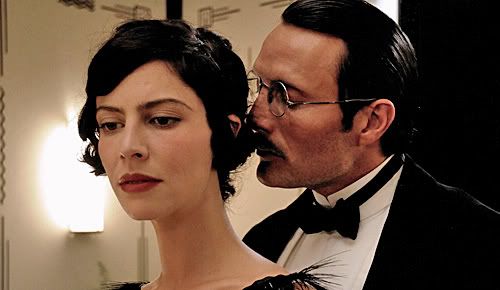
Pictured: Anna Mouglalis and Mads Mikkelsen
Paris 1913. Coco Chanel is dressing for the theatre in the company of her lover, Boy Capel. Igor Stravinsky sits nervously backstage at the Theatre du Champs-Elysees with his supportive wife Catherine, bracing for the infamous opening performance of ‘The Rite of Spring.’ As the story goes, it is met with a riotous and outraged audience. Everyone is on their feet shouting obscenities at the stage or each other - everyone, it seems, except Mademoiselle Chanel, who sits quietly absorbing the experience on an entirely internal level, expressing hardly the slightest emotion. Stravinsky, too, reveals nothing externally, but inwardly contemplates the failure before him.
Despite Coco’s presence on this night, the two do not formally meet until 1920, a location in time the film jumps to after a somewhat awkwardly placed montage of footage from the Russian Revolution and WWI. In their personal lives, Coco has lost Boy to a fatal car accident but witnessed the continued growth of her empire, and Igor's life has been uprooted by the war and its lingering effects, one of which is a somewhat nomadic lifestyle for him and his family. After a few encounters during which a reciprocal fascination is profoundly felt, Coco invites Igor and his family to live at her villa (one of the few verifiable facts of the film).
(This is a somewhat longer review - please follow the jump for the rest.)
It doesn’t take long for either creative giant to realize the attraction between them. However, it is an attraction based not upon any sort of deep connection to each other’s soul or spirit, but on a shared understanding of the emotional isolation that comes with knowing one’s own genius. They recognize their own self-absorption in the other. Even when they make love, both are clearly far more concerned with their own performance than anything else, critiquing and adjusting as he would his music or she her fashions. On the rare occasion that they do look at each other in the throes of passion, it is only to share in a prideful admiration of what they consider simply another impeccably constructed work of art. In other words: ego as aphrodisiac.
I don’t think it needs to be said that the film is dripping with aesthetic appeal. Between the reconstruction of the Ballet Russes' costumes in the debut of 'Rite of Spring' to the wardrobe of Chanel, this surely made costume designers everywhere absolutely salivate. Not to mention Coco’s idyllic country oasis with its crisp, clean interior design (the Chanel trademark, of course). Cinematographically there is much to be admired here as well, with a rich variety of angles and focus, along with several noteworthy tracking shots that guide us through everything from backstage pandemonium to the boisterous parties of the 1920s. Several times the film strikes you with aerial views, such as one of Coco wandering through her chambers and later of her and Igor in the midst of making love. I don’t think there is such a thing as an expected aerial shot, and their jarring quality is used to full effect throughout.
The script is one of the more meticulous I’ve come across recently. Not a single word is spared. Anything that can be conveyed sans dialogue is, making for some particularly resonating moments. One example that springs to mind is toward the end of the film. After Coco and Igor have wounded each other as much as they seemingly can, they quietly reconcile one morning as she watches him bathe, both of them eventually easing into resigned laughter, wordlessly acknowledging their own pettiness in the face of their rather dismal - and dwindling - relationship.
Mads Mikkelsen is a quiet and severe Igor, presenting him as a man who doesn’t care whether or not you take him seriously, he takes himself seriously enough for the rest of the world. Anna Mouglalis gives Coco an effortless cool; the kind of woman you can’t imagine would sweat under any amount of pressure. As one party guest aptly puts to Igor, “She even makes grief look chic.” Neither the actors nor director Jan Kounen seem intent on making these people appear ‘likeable' in any obvious sense, which on a certain level I appreciate. I don’t think anyone believes that cultural icons the likes of Coco Chanel and Igor Stravinsky got where they did by being nice. Least of all, as this film tells it, to each other.
No comments:
Post a Comment